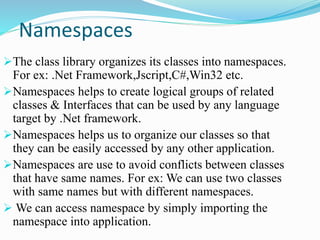
Namespaces in C#
- 1. Namespaces The class library organizes its classes into namespaces. For ex: .Net Framework,Jscript,C#,Win32 etc. Namespaces helps to create logical groups of related classes & Interfaces that can be used by any language target by .Net framework. Namespaces helps us to organize our classes so that they can be easily accessed by any other application. Namespaces are use to avoid conflicts between classes that have same names. For ex: We can use two classes with same names but with different namespaces. We can access namespace by simply importing the namespace into application.
- 2. Net uses (.) operator as a delimeter between class & namespace A namespace definition begins with the keyword namespace followed by the namespace name as follows: namespace namespace_name { code declarations }
- 3. using System; namespace first_space { class namespace_cl { public void func() { Console.WriteLine("Inside first_space"); } } } namespace second_space { class namespace_cl { public void func() { Console.WriteLine("Inside second_space"); } } } class TestClass { static void Main(string[] args) { first_space.namespace_cl fc = new first_space.namespace_cl(); second_space.namespace_cl sc = new second_space.namespace_cl(); fc.func(); sc.func(); Console.ReadKey(); } }
- 4. The using Keyword The using keyword states that the program is using the names in the given namespace. For example, we are using the System namespace in our programs. The class Console is defined there. We just write: Console.WriteLine ("Hello there");
- 5. Few Namespaces & their description Namespaces Description System Include essential classes & base classes for commonly use datatype, events & so on System.Windows.Forms.Form Include classes needed to create Window form. System.Windows.Forms.Button Include classes needed for using button. System.Data Include classes that make up ADO.NET System.SqlClient Include classes that support SQL server .Net provider. System.XML Include classes that support XML. System.Web Provides Classes & Interface that support browser server communication. System.Net Provides Interface to protocols used on Internet
- 6. Assembly The namespace are placed within Assemblies. Assemblies are the building blocks of .Net application, the common language runtime does not support types outside of assemblies. Assembly files are located on somewhere on the disc that are defined as Portable Executable(PE). An Assembly is a single deployable unit that contains the all information about the implementation of classes, structure & Interface. An Assembly stores all information about itself. Dot NET assemblies may or may not be executable, i.e., they might exist as the executable (.exe) file or dynamic link library (DLL) file.
- 7. Assembly & metadata provides the CLR with the information required for executing the application. For ex. If an application uses a component the assembly keeps tracks of version no of component used in application. The Assembly provides the information to the CLR while application being executed.
- 8. Components of Assembly Assembly consist of Manifest, Module & Type Manifest describe the Manifest. It contains.. Name & version no of assembly Its Interaction information with other assemblies. Security permission required by the assembly Module is either a DLL & EXE file. It contains.. Compiled code or Intermediate language code Metadata associated with module. Type is a class that contains data & logic affecting the data.
- 9. Functions of Assembly An assembly in .Net framework performs following functions.. Support Execution Provide security Provide unique identification Track version Support Deployment Support side by side execution
- 10. Private Assembly and a Shared Assembly Private assembly can be used by only one application. Private assembly will be stored in the specific application's directory or sub-directory. There is no other name for private assembly. Private assembly doesn't have any version constraint.
- 11. Public Assembly: Public assembly can be used by multiple applications. Public assembly is stored in GAC (Global Assembly Cache). Public assembly is also termed as shared assembly. Public assembly should strictly enforce
- 12. Compiler: When you compile a program developed in a language that targeted the CLR instead of compiling the source code into machine level code , the compiler translate the source code into Microsoft Intermediate Language or IL. This ensures language interoperability. The compiler also produces metadata about the program during the process of compilation. The process of compiling & executing the managed code is given below..
- 13. Metadata contains the description of the program such as the classes & interface, the dependencies & the version of component used in the program. Class loader: When we execute the .EXE & .DLL file the code & all other information from the base class library is sent to the class loader. The class loader loads the code into memory.
- 14. Before the code can be executed ,the .Net framework needs to convert the IL into native or CPU specific code. The just In time compiler translate the code from IL into manage native code. The CLR supplies a JIT compiler for each supported CPU architecture. During the process of compilation the JIT compiler compiles the code that is required during execution instead of compiling the complete IL code When an uncompiled method is invoke during execution the JIT compiler converts the IL for that method into native code JIT Compiler
- 15. This process saves the time & memory required to convert the complete IL into native code During JIT compilation the code is also checked for type safely. Type safely ensures the objects are always accessed in a compactable way. Type safely also ensures that objects are safely isolated from each other & are therefore safe from any corruption.